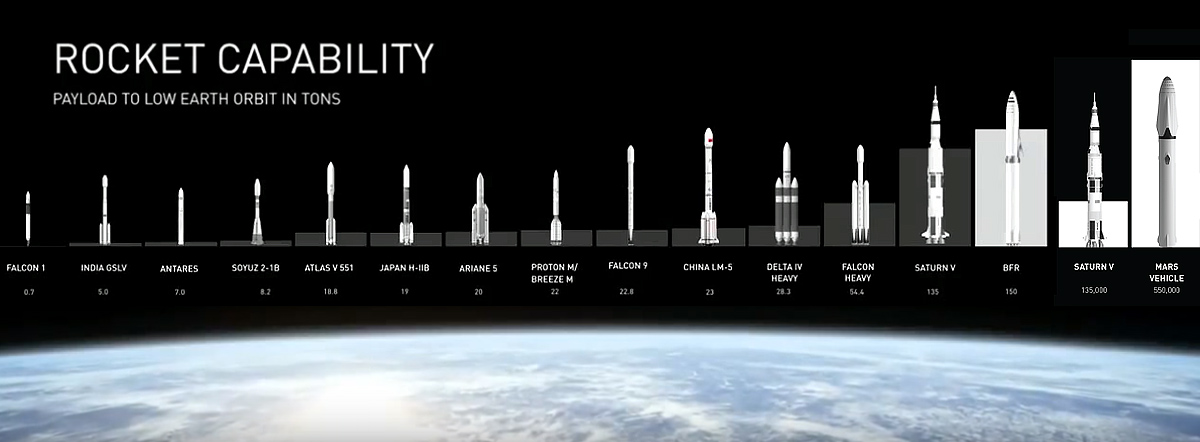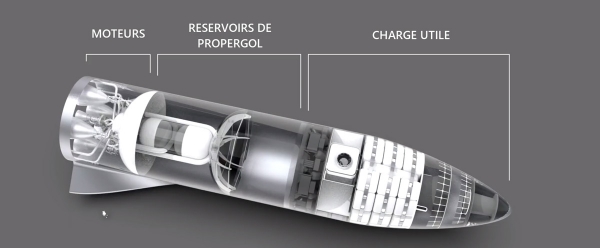

The inhabited missions...
In terms of astronautics, robotic missions have become almost routine, whether to land on Mars a fixed or mobile laboratory, or to place a satellite in orbit. For manned flights it's another story but Elon Musk gives us hope.
In fact the problem is primarily a mass problem. Many launchers built in the world today are able to send a few kilograms into Mars orbit or onto the surface of Mars. Once put in orbit, operating a satellite (an "orbiter" as we say) seems relatively easy, controlling an "EDL" (for "Entry, Descent, Landing") down to the surface of Mars is much more difficult. Until now only the Americans have succeeded and for a mass of one ton maximum (Curiosity). This is enough for a robotic mission but not for an inhabited mission. In his "Mars Direct" architecture, Robert Zubrin computed that it is necessary to be able to land at least forty tons, or rather twice 20 tons (a first mission, robotic, to prepare the second, inhabited, in particular by producing the energy needed for the return leg, using local resources).
These constraints involve (1) being able to extract from the Earth gravity “well” and put into a Low Earth Orbit ("LEO") about 130 tons (including the 20 tons to be landed) and (2) having the means to enough decelerate the mass descending (falling!) onto the surface. We have been able to make heavy launchers that can put 130 tons in LEO (Saturn V, Apollo program), we know less well how to lay 20 tons on the surface. Until now the EDL process was to use a combination of various braking devices : heat shield (possibly inflatable to give it a larger area), parachute, ballute, airbag or retrorockets for the last meters, to use at a maximum the advantage of Mars, that is to say its atmosphere.
 With his recovery / re-use technology, developed on his Falcon-9 and Falcon-Heavy, as well as with his BFR project, Elon Musk has changed it all. Now we can consider that the retro-propulsive descent of a hundred tons through the entire atmosphere of Mars (a little over a hundred km thick) will be possible. And we can consider this mode of descent because Elon Musk had the audacity to conceive and engage (1) the realizing of a huge ship (the BFR version 2 will put 150 tons in LEO); (2) the propellant refueling in orbit of the second stage of the launcher, before its trans-Martian injection, so that the tanks are fully refilled after the enormous consumption required for putting the vessel on LEO (95% of the total propellant carried from Earth surface); (3) controlled retropropulsed descent following the same principles as developed and demonstrated by the return to Earth of the first stages of the Falcon launchers after they completed their mission. Of course the BFR is still a concept but the success of the launch of the Falcon Heavy and the safe return of two of its three launchers generated the legitim hope that it will be possible (and the new "Raptor" engine was successfully tested).
With his recovery / re-use technology, developed on his Falcon-9 and Falcon-Heavy, as well as with his BFR project, Elon Musk has changed it all. Now we can consider that the retro-propulsive descent of a hundred tons through the entire atmosphere of Mars (a little over a hundred km thick) will be possible. And we can consider this mode of descent because Elon Musk had the audacity to conceive and engage (1) the realizing of a huge ship (the BFR version 2 will put 150 tons in LEO); (2) the propellant refueling in orbit of the second stage of the launcher, before its trans-Martian injection, so that the tanks are fully refilled after the enormous consumption required for putting the vessel on LEO (95% of the total propellant carried from Earth surface); (3) controlled retropropulsed descent following the same principles as developed and demonstrated by the return to Earth of the first stages of the Falcon launchers after they completed their mission. Of course the BFR is still a concept but the success of the launch of the Falcon Heavy and the safe return of two of its three launchers generated the legitim hope that it will be possible (and the new "Raptor" engine was successfully tested).
Note that manned missions would already be possible with Falcon Heavy, although rather rough, "spartan" I would say (with more than two flights and leaving an ERV – “Earth Return Vehicle” - in Martian orbit). Both Robert Zubrin and Jean-Marc Salotti will demonstrate it to you if you attend EMC18 and listen to their updated versions of "Mars-semi-direct".
Of course for a trip of this duration (six months of travel to go, six to come back and 18 months on site, given the evolution of the position of the planets relative to each other) a good launcher is not enough. A very important factor is life support. Another one is protection against space radiation.
For life support, Environment Control & Life Support System (ECLSS) technologies have been studied and tested for years, including MELiSSA (Micro Ecological Life Support System Alternative) or ESTEE (Earth Space Technical Ecosystem Enterprises). These technologies involve the recycling of gases, liquids and solids but also the control of microbiota within the relatively small microbiome (no buffer effect!) that is a space vessel or a base on Mars. We may say that it is difficult (an Italian specialist, Professor Alberto Bemporad, compared the control of the microbiome of a space vessel to the driving of a race car!) but that important progress have been made which already noticeably limit the masses to send off, with the added advantage that on Mars we will be able to use local water and chemical elements that we can combine (by means of solar energy - local, and / or nuclear energy - imported) to obtain products necessary for the purification, stabilization of the environment or production of food in greenhouses.
 Radiation protection is a difficult subject. We can protect ourselves from the storms, “SPE” (for “Solar Particle Event”), of solar particles, “SeP” (for Solar energic Particles), because they are protons and because water and food supplies, rich in water, contain a lot of those (hydrogen). When one SPE occurs, travelers will be able to take shelter in caissons surrounded by their water supplies and this will slow spatial protons down sufficiently. It is not the same for galactic radiations (GCR) of high atomic mass (HZE). They are scarce (2%) but go through everything. There is nothing to do except to go from one sheltered place (the Earth) to another (Mars) as fast as possible. In normal cruising time, when there is no SPE, an "AstroRad" vest (made by StemRad) will be adequate to counter the normal flow of protons. Indeed nobody wants to be irradiated and doses should be “as low as readily available” (ALARA). On Mars the level of radiations is quite different (about the same as in the ISS and shelter is possible). If one wants to take only an "acceptable" dose of cumulated radiation, a trip of six months would be bearable, four trip of six months probably not. We should therefore shorten the trip to the maximum, but this will be at the expense of the payload transported. Elon Musk plans to reduce people's travel time from six to four months, while cargo ships will "take their time" (between 6 to 9 months).
Radiation protection is a difficult subject. We can protect ourselves from the storms, “SPE” (for “Solar Particle Event”), of solar particles, “SeP” (for Solar energic Particles), because they are protons and because water and food supplies, rich in water, contain a lot of those (hydrogen). When one SPE occurs, travelers will be able to take shelter in caissons surrounded by their water supplies and this will slow spatial protons down sufficiently. It is not the same for galactic radiations (GCR) of high atomic mass (HZE). They are scarce (2%) but go through everything. There is nothing to do except to go from one sheltered place (the Earth) to another (Mars) as fast as possible. In normal cruising time, when there is no SPE, an "AstroRad" vest (made by StemRad) will be adequate to counter the normal flow of protons. Indeed nobody wants to be irradiated and doses should be “as low as readily available” (ALARA). On Mars the level of radiations is quite different (about the same as in the ISS and shelter is possible). If one wants to take only an "acceptable" dose of cumulated radiation, a trip of six months would be bearable, four trip of six months probably not. We should therefore shorten the trip to the maximum, but this will be at the expense of the payload transported. Elon Musk plans to reduce people's travel time from six to four months, while cargo ships will "take their time" (between 6 to 9 months).
 You will have noticed that I am not talking about ESA or NASA. The reason is that (1) ESA does not have the means and is not interested in deep space spaceflight (for me going to the Moon is not travelling into “deep space”) and (2) NASA has fallen behind Space-X in astronautics technology and has failed to develop its own heavy launcher, the SLS (Space Launch System). It was in 2006 that the concept was launched (Ares, part of the Constellation program) while the concept of Falcon Heavy was announced in 2011, and it now exists and flies!
You will have noticed that I am not talking about ESA or NASA. The reason is that (1) ESA does not have the means and is not interested in deep space spaceflight (for me going to the Moon is not travelling into “deep space”) and (2) NASA has fallen behind Space-X in astronautics technology and has failed to develop its own heavy launcher, the SLS (Space Launch System). It was in 2006 that the concept was launched (Ares, part of the Constellation program) while the concept of Falcon Heavy was announced in 2011, and it now exists and flies!
It will thus be Elon Musk who will land the first inhabited rocket on Mars. Now, economy of scale being the source of financially acceptable travels by reducing unitary costs, any diversification of heavy launcher-consuming objectives (the Moon for instance) will be welcome...as long as they do not overshadow and lead to forget the Martian goal.


